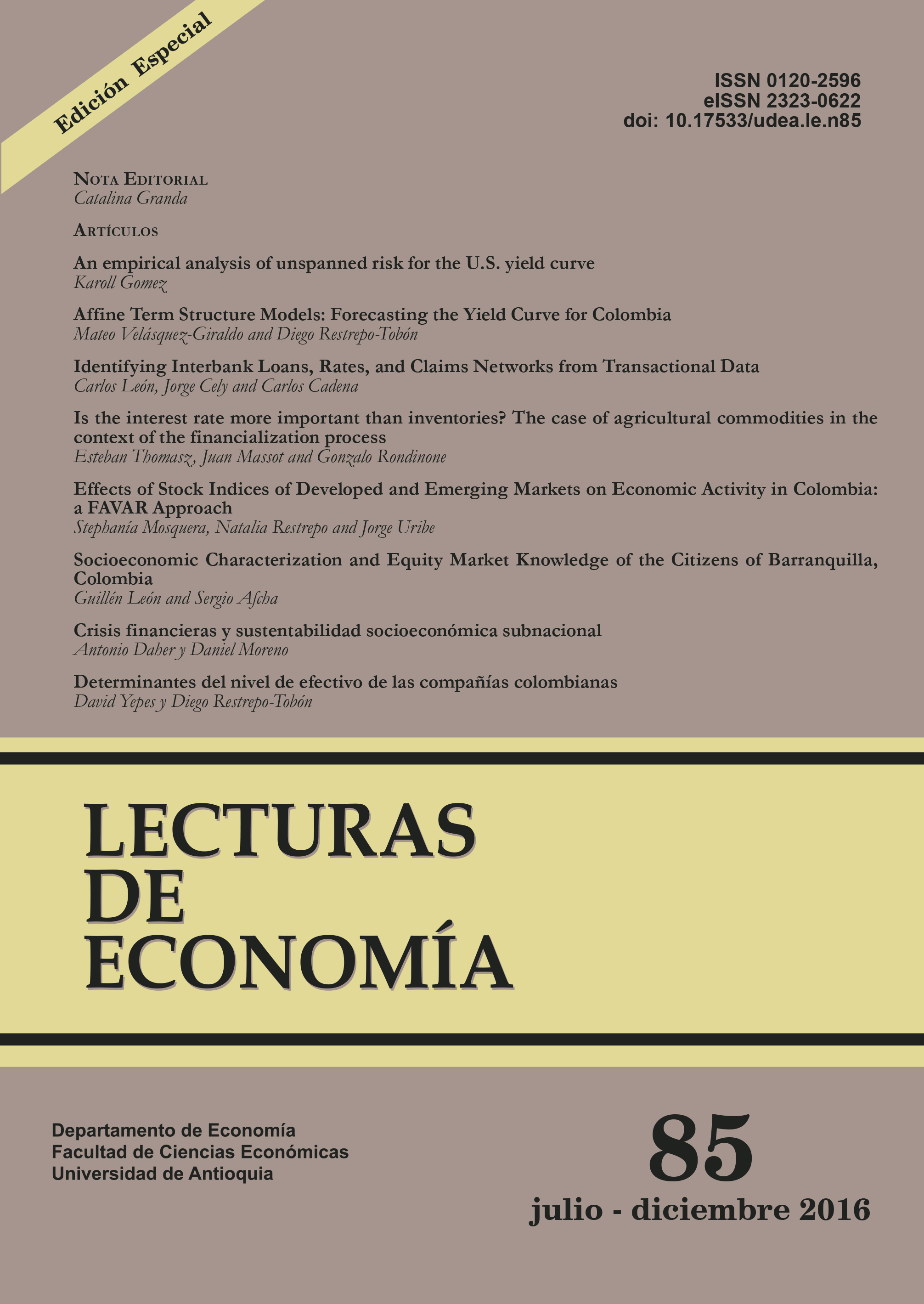Affine Term Structure Models: Forecasting the Yield Curve for Colombia
DOI:
https://doi.org/10.17533/udea.le.n85a02Keywords:
term structure, forecasting, interest rates, multifactor modelsAbstract
Superior modeling of the yield curve is useful for asset pricing, financial planning, and risk management. In this article, we estimate five affine term structure models using daily data for Colombia. We find that a three-factor model outperforms the other models in one and five day ahead forecasts. The model factors closely mimic empirical proxies for the level, the slope, and the curvature of the yield curve in Colombia.
Downloads
References
Ait-Sahalia, Yacine (2008). “Closed-form likelihood expansions for multivariate diffusions”, The Annals of Statistics, Vol. 36, No. 2, pp. 906-937.
Ait-Sahalia, Yacine & Kimmel, Robert L. (2010). “Estimating affine multifactor term structure models using closed-form likelihood expansions”, Journal of Financial Economics, Vol. 98, No. 1, pp. 113-144.
Ang, Andrew & Piazzesi, Monika (2003). “A no-arbitrage vector autoregression of term structure dynamics with macroeconomic and latent variables”, Journal of Monetary Economics, Vol. 50, No. 4, pp. 745-787.
Bliss, Robert R. (1996). “Testing term structure estimation methods”, Working Paper No. 96-12a. Federal Reserve Bank of Atlanta.
Brandt, Michael W. & He, Ping (2006). “Simulated likelihood estimation of affine term structure models from panel data”, Working paper. Retrieved from: http://ssrn.com/abstract=885682 (May 13th).
Campbell, John Y. (1986). “A defense of traditional hypotheses about the term structure of interest rates”, The Journal of Finance, Vol. 41, No. 1, pp. 183-193.
Campbell, John Y. & Shiller, Robert J. (1991). “Yield spreads and interest rate movements: A bird’s eye view”, The Review of Economic Studies, Vol. 58, No. 3, pp. 495-514.
Christensen, Jens H., Diebold, Francis X. & Rudebusch, Glenn D. (2011). “The affine arbitrage-free class of Nelson-Siegel term structure models”, Journal of Econometrics, Vol. 164, No. 1, pp. 4-20.
Cox, John C., Ingersoll, Jonathan E. Jr & Ross, Stephen A. (1985). “An intertemporal general equilibrium model of asset prices”, Econometrica, Vol. 53, No. 2, pp. 363-384.
Dai, Quiang and Singleton, Kenneth J. (2000). “Specification analysis of affine term structure models”, The Journal of Finance, Vol. 55, No. 5, pp. 1943-1978.
Diebold, Francis X. & Li, Canlin (2006). “Forecasting the term structure of government bond yields”, Journal of Econometrics, Vol. 130, No. 2, pp. 337-364.
Diebold, Francis X. & Rudebusch, Glenn D. (2013). Yield Curve Modeling and Forecasting: The Dynamic Nelson-Siegel Approach. Princeton. Princeton University Press.
Diebold, Francis X., Rudebusch, Glenn D. & Aruoba, S. Boragan (2006). “The macroeconomy and the yield curve: a dynamic latent factor approach”, Journal of Econometrics, Vol. 131, No. 1, pp 309-338.
Duan, Jin-Chuan & Simonato, Jean-Guy (1999). “Estimating and testing exponential-affine term structure models by Kalman filter”, Review of Quantitative Finance and Accounting, Vol. 13, No. 2, pp. 111-135.
Duffee, Gregory R. (2002). “Term premia and interest rate forecasts in affine models”, The Journal of Finance, Vol. 57, No. 1, pp. 405-443.
Duffie, Darrell & Kan, Rui (1996). “A yield-factor model of interest rates”, Mathematical Finance, Vol. 6, No. 4, pp. 379-406.
Durham, J. Benson (2006). “An estimate of the inflation risk premium using a three-factor affine term structure model”, Finance and Economics Discussion Series 2006-42. Board of Governors of the Federal Reserve - Monetary and Financial Market Analysis Section.
Fama, Eugene F. & Bliss, Robert R. (1987). “The Information in Long- Maturity Forward Rates”, The American Economic Review, Vol. 77, No. 4, pp. 680-692.
Ho, Hsiao-Wei, Huang, Henry H. & Yildirim, Yildiray (2014). “Affine model of inflation-indexed derivatives and inflation risk premium”, European Journal of Operational Research, Vol. 235, No. 1, pp. 159-169.
Maldonado-Castaño, Rogelio, Zapata-Rueda, Natalia & Pantoja- Robayo, Javier O. (2014). “Dynamic estimation of an interest rate structure in Colombia: Empirical analysis using the Kalman filter”, Journal of Economics Finance and Administrative Science, Vol. 19, No. 37, pp. 70-77.
Melo-Velandia, Luis F. & Castro-Lancheros, Giovanni (2010). “Relación entre variables macro y la curva de rendimientos”, Borradores de Economía, No. 605. Banco de la República, Colombia.
Nelson, Charles R. & Siegel, Andrew F. (1987). “Parsimonious modeling of yield curves”, The Journal of Business, Vol. 60, No. 4, pp. 473-489.
Piazzesi, Monika (2010). “Affine term structure models”. In: Aït-Sahalia, Yacine & Hansen, Lars P. (Eds.), Handbook of financial econometrics: Tools and Techniques (pp. 691-76). Amsterdam, Elsevier.
Restrepo-Tobón, Diego A. & Botero-Ramírez, Juan C. (2008). “Modelos unifactoriales de tipos de interés: aplicación al mercado colombiano”, Cuadernos de administración, Vol. 21, No. 36, 2008.
Singleton, Kenneth J. & Umantsev, Len (2002). “Pricing coupon-bond options and swaptions in affine term structure models”, Mathematical Finance, Vol. 12, No. 4, pp. 427-446.
Storn, Rainer & Price, Kenneth (1997). “Differential evolution-a simple and efficient heuristic for global optimization over continuous spaces”, Journal of Global Optimization, Vol. 11, No. 4, pp. 341-359.
Vasicek, Oldrich (1977). “An equilibrium characterization of the term structure”, Journal of Financial Economics, Vol. 5, No. 2, pp. 177-188.
Welch, Ivo & Goyal, Amit (2008). “A comprehensive look at the empirical performance of equity premium prediction”, Review of Financial Studies, Vol. 21, No. 4, pp. 1455-1508.
Published
How to Cite
Issue
Section
License
This page, by Universidad de Antioquia, is licensed under a Creative Commons Attribution License.
Authors who publish with this journal agree to retain copyright and grant the journal right of first publication, with the article licensed under a Creative Commons Attribution-NonCommercial-ShareAlike License allowing others to share it as long as they acknowledge its authorship and original publication in this journal.
Authors can enter into separate, additional contractual arrangements for the non-exclusive distribution of the journal's published version of the work (e.g., post it to an institutional repository or publish it in a book), provided that these arrangements be not for profit and the journal be acknowledged as the original source of publication.
Authors are permitted and encouraged to post their papers online (e.g., in institutional repositories or on their websites), as it can lead to valuable exchanges as well as greater citation of the published work.







